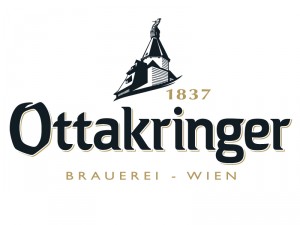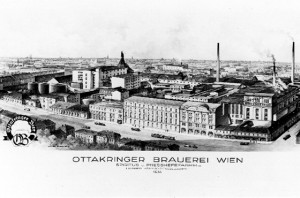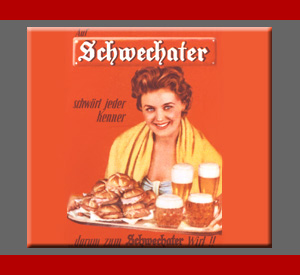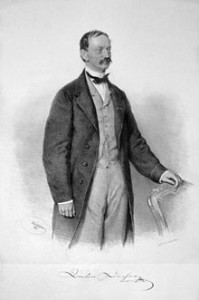Viennese beer – part 2
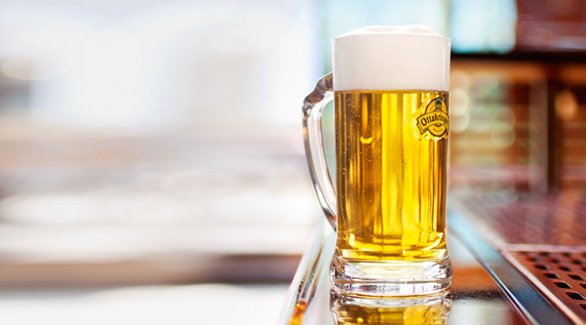
Viennese breweries and beer retailers
The beer city of Vienna has several highlights to offer. This is based, of course, on the large and small breweries – some of them with a long tradition – that produce the golden yellow “barley juice,” sell it and/or pour it directly. Join me in visiting Viennese breweries that pursue their own passion and that of beer drinkers with tradition, innovation and considerable taste.
Major players
Ottakringer Brewery – tradition and modernity
Anyone who lives in Ottakring – Vienna’s 16th District – or wanders around the buildings there every now and then smells two scents primarily: chocolate from the nearby Manner factory as well as the smell of yeast from Ottakringer Brewery. The impressive industrial building is so much a matter of course for residents that they hardly notice it anymore – except when there’s an event or trade show or clubbing taking place on the brewery’s premises. Depending on the occasion, young and old alike appear and enjoy the many different beers of the traditional brewery, which made the leap into modern times with flying colors. Professional brewing technology, the best raw materials, openness to the needs of the market, as well as comprehensive new marketing strategies were and are the keys to success.
1837 is considered the year of birth of Ottakringer Brewery. Back then, the master miller Heinrich Plank received official permission to brew from Klosterneuburg Monastery and built the first brewery in Ottakring. With the beginning of the “Kuffner” era around 1850, the brewery was developed into a model of its kind. The following generations continued to focus on further development. The Ottakringer Brewery thus went public as a corporation on the stock exchange in 1905 and underwent an immense economic and societal boom.
In 1938, Moritz Kuffner was forced to flee to Switzerland, and the brewery was sold to Gustav Harmer. During the war years, only 2.5-degree beer was brewed due to a shortage of raw materials. Beer was brewed once again already on June 21, 1945, which spurred considerable optimism. The Gold Fassl age started during the years of economic boom at the beginning of the 1960s. Dr. Harmer and certified trader Wenckheim led the brewery, by withdrawing from the beer cartel, to a future in which restaurateurs could freely select their beer supplier.
Forward-looking marketing strategies such as the introduction of the green beer bottle, an alcohol-free beer, consistent new labels, the “blopp” freshness seal, several new types of beer and – not to be forgotten – stirring and humorous advertisements continue to bring the Ottakringer Brewery to the awareness of restaurateurs and consumers. They keep coming up with new things and are oriented towards the preferences and desires of the fans. Beers that taste good. Parties to be remembered. The two of them account for Ottakringer Brewery’s success. The Schick hotels and restaurants in Vienna have offered Ottakringer beer for many years, and it is very popular with guests.
Schwechater – recht hat er (it’s right)
Who in Vienna does not know this advertising slogan? Yes, you’re entirely right, Schwechater Brewery is not actually located in Vienna, but it has been considered a Viennese brewery since time immemorial. The Schwechater Brewery is part of Brauunion Österreich, the largest group of breweries in Austria, yet the individuality of the historical company has remained.
Peter Descrolier, valet and purser of Archduke Mattias, founded the brewery Klein-Schwechat in 1632. The success story of Schwechater beer began in 1760, when Franz Anton Dreher came to Vienna as a waiter. He purchased the Klein-Schwechat Brewery in 1796 for 19,000 guilder and led it, along with other breweries, to remarkable success.
Anton Dreher, the son of Franz Anton Dreher, was born in 1810. Through travels to Munich and England, he prepared himself for his future existence as a master brewer by collecting comprehensive knowledge about the art of brewing. In 1836, Anton Dreher first took on the lease at the Klein-Schwechat brewery. He bought the brewery from his mother in 1839.
In 1841, Dreher lagered a light-colored, bottom-fermented beer for the first time and, after completing its lager period, brought it to Vienna under the brand “Klein-Schwechater Lagerbier.” In Vienna, it was received with such enthusiasm that the Viennese only wanted to drink Schwechater from that point on. This was the hour of birth of today’s “lager” beers which are now represented throughout the world. The major onrush of lager beer also entailed enlisting the aid of machines, however. In 1848, Dreher became the first brewer in Austria to introduce a steam engine for brewing beer. This is exhibited today in the Technisches Museum Wien!
Over the course of the 1850s, the Schwechat Brewery became the largest brewery on the European continent and batches of “Klein Schwechater Lager” traveled far beyond Austria’s borders. Dreher received the gold medal with a diploma at the International Exposition in Paris in 1867.
The name of the brewery was changed to “Anton Drehers Brauereien Aktiengesellschaft” in 1905 under the leadership of Anton Dreher, Jr.. During the First World War there were high taxes due to the war chest. The 130-year history of the Dreher family dynasty with the Schwechat Brewery ended in 1921.
During the Second World War, only 2.4-degree lager beer was brewed due to shortages in raw materials – this was called “Brauerschwitz” (“brewer’s sweat”) in the vernacular. In 1945, the Schwechater Brewery was nearly entirely destroyed. 12-degree lager beer was not brewed again until September 1, 1945. Reconstruction commenced under Dipl.Ing. Dr. h.c. Manfred Mautner Markhof.
In 1978, the Brauerei Schwechat AG company was merged into Österreichische Brau AG, and thereby into the later Brauunion.
Today, around 800,000 hectoliters of superb beer are produced on the enormous area of Brauerei Schwechat by around 60 employees. 60,000 half-liter cans or 78,000 one-third-liter bottles can be filled per hour. A vehicle fleet of around 34 trucks ensures that beer is provided to the gastronomy and food industries.
Small and fine
In addition to the “majors,” around a dozen brewpubs and small breweries have established themselves in recent years. The range of products is broad, ranging from simple draft beer all the way to extravagant specialties, very much accommodating the elevated requirements and desires of beer drinkers through the sheer variety of beer types. That the small and microbreweries are mostly coupled with restaurants is a very pleasant side effect for guests. I’ll mention a couple of the “small and fine” breweries here.
Siebenstern-Bräu is considered a pioneer and creative beer guru. Already in the 1990s, “Vollmund” (full-bodied) beer was brewed here, and imaginative creations such as hemp beer and chili beer followed. Beers with special malts were produced here, which are especially pleasurable to drink.
The second-oldest Viennese brewpub, Medl Bräu in the 14th District, was founded from lottery winnings. Johann Medl founded his operation in a former vehicle factory in 1987 – and to this day has not changed his basic concept, including his proven recipes, to the good fortune of the many regulars.
The pioneer par excellence is Fischer Bräu. As a forefather of the Viennese nightspot scene (opening of the Krah-Krah and start of the so-called Wiener Beisl boom in 1980), Sepp Fischer founded his brewpub already in 1985, accompanied by suitable culinary delicacies like the legendary giant brown breads (Schwarzbrot) au gratin. Even the brewery’s sale twelve years ago did not change this concept. Naturally, special beers or holiday bocks are brewed here every now and then; otherwise the saying holds: Never change a winning concept.
From the oldest to one of the youngest brewpubs – Lichtenthaler Bräu first caught my attention in an article in A la Carte magazine. Extravagant craft beers are brewed here in the 9th District in tiny batches. The numerous creations are then recommended to accompany culinary delicacies very professionally and individually.
Beer from all over the world in Vienna
In Vienna, beer lovers not only have access to domestic beers. In the meantime, there are also several stores in which genuine beer fans have access to foreign beer varieties.
Here are a few “shopping tips”:
Ammersin, 1130 Vienna: You can find beers from Australia to Zimbabwe (well, from A to Z) on over 20 meters of shelf space.
Böhle, 1010 Vienna: Special beers from Greenland, Cuba, or Chinese rice beer, and lots more.
Have fun shopping!
 TIP:
TIP:
From May 16 to 18, 2014, the first Craft Beer Festival will take place at ADRIA Wien. Domestic and international producers, tastings, discussions and commented presentations of specialties are on the program. Tickets cost € 45.00. For details, visit www.craftbierfest.at.
In Part 3 of “Viennese Beer,” I’ll go on the enjoyment offensive and ask: Is it possible to “eat” beer in the highest quality foods? A small “Viennese beer lexicon” for true fans will also be included!
Image and data credits: © Ottakringer, Schwechater, A la Carte Bookazine.


